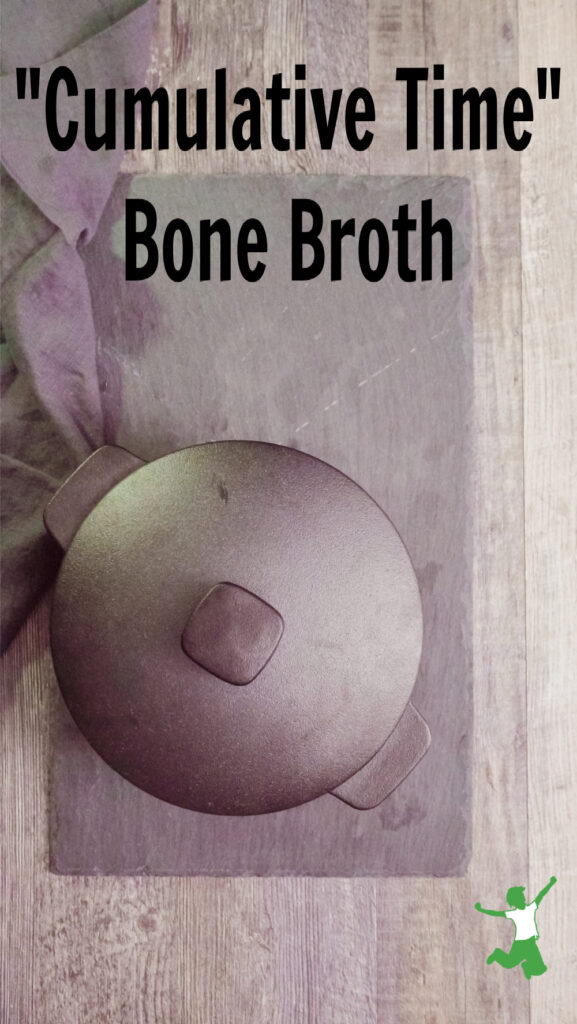Table of Contents[Hide][Show]
How to follow the “cumulative time” method for making bone broth, a strategy that does not involve leaving a simmering pot on the stove overnight or unattended while you are out of the house.

A big concern people have when they start learning how to make bone broth at home is about leaving a simmering stockpot on the stove for many hours.
Depending on when you start the process, this could entail leaving the pot simmering overnight or while you are out of the house temporarily.
This can be an unacceptable fire risk, so what to do in those situations?
While successfully producing a gelatinous pot of broth is critical, it should not involve a safety hazard to accomplish!
Fortunately, there are several options for avoiding this problem.
First of all, you can make meat stock or fish head broth. Both of these require only a couple of hours at the most to make.
If you are so time-crunched that you need something even quicker than that, I suggest bonito broth. This type of stock only requires the time necessary to boil a pot of filtered water.
Cumulative Time Bone Broth
At some point, however, you are going to need to make a proper pot of chicken or beef stock.
This type of long-simmering broth will require significantly longer than a couple of hours on the stove or in a slow cooker like a Vita-Clay.
In that situation, the cumulative time method is recommended. This is the approach suggested by Monica Corrado, CNC CGP of Simply Being Well.
She introduced me to this concept at a traditional health conference in Baltimore.
Monica really knows ancestral cooking like few others I’ve ever met. In addition to being a chef, she’s also a GAPS Practitioner. She has significantly helped my husband with his GAPS Diet journey…which requires a lot of properly made bone broth.
According to Monica, the cumulative time approach for making bone broth simply means that the required simmering time for a particular type of stock can either be continuous or broken up into sections that equal the total required duration when added together.
The catch is that each time you start to heat the broth again, you must bring it to a boil, skim the foam, and then lower the heat back down to a simmer.
Avoid the temptation of simply bringing the pot back to a quick simmer.
You must bring it to a boil first, skim and then reduce the heat to a simmer with the lid on. In other words, just repeat what you did at the beginning of the process.
What to Do When the Heat is Turned Off
There is no need to move the stockpot in and out of the refrigerator between simmering sessions on the stove.
This is because the pot stays very hot for hours after the heat is turned off.
For pathogens to start to grow, the stockpot would need to be at room temperature for 4+ hours.
Anyone who is experienced in making stock knows that a stockpot with the lid on will stay hot for many hours. It won’t get to room temperature for 4+ hours for at least half a day!
In my experience, the pot also will not get to room temperature if you turn off the heat and leave it on the stove overnight.
If the length of time to make bone broth had you concerned in the past, try the cumulative time approach!
An easy way to keep track is to keep a little notebook in the kitchen. Then, you can log the total amount of time the stock has simmered. This will ensure quality, gelatin-rich broth when you are finished.
Making stock safely couldn’t be easier when using the cumulative time method!








Or come into either GRUB locations and pic up some high quality freshly made stock today!
So, I think you answered this in your post above, but it is safe to leave stock on the stove top for longer than two hours? I have small children so I’m always worried of food poisoning them. I try to get my stock in the fridge right away after cooking, but then I heard that you have to let food cool before putting in the fridge. I’m confused can you help me with this?
Do you ever have a problem with the liquid becoming too low? I was wondering if you have to add water at any point and if so does that dilute the broth or hinder the gel?
Sarah,
I sometimes make my stock in a crock. This time I added about 15 carrots (to use for others meals w/the chicken). My soup turned out a very dark brownish/orange tea color almost. I think its from the carrots. Would this be ok? The soup has a good taste.
I’ve tried the crockpot – my settings are high (4 hrs), medium (6 hrs), low (8 hrs), and warm (10 hrs). Low keeps foods at a steady boil, with warm there are no signs of bubbles. I have searched and searched for a crockpot that allows you to set temperatures but have never found one. I think I heard it has something to do with safety. But I wonder why it should be different than an oven.
@ Shirley J: I’ve had trouble with crock pots, too, in regard to temperatures. Mine (I have three) get so hot I can fry chicken in them! They are not made the same as when they first arrived on the market back in the 1970’s or whenever. They were actually better back then. Everyone is hoarding the old ones!
My DH was a firefighter (now retired) but the difference between a crock pot and a stove is the voltage. Anything which plugs into a wall is a potential fire hazard, of course, but the small appliances are where he saw the most damage over the years from kitchen fires. For years I have kept all of my small, counter-top appliances unplugged except when in use. I keep my toaster unplugged and covered with a tea towel because it’s right next to my kitchen window and I DO NOT like toasted bugs! Also, my DH literally preaches to women never to use the plug-in air freshners (like Glade and a few others) and he almost went bonkers when they introduced a line of mentholy / Vicks-y type scented plug-ins to use in kid’s rooms! He just stood here in front of the TV and hollered “no, no, no!! those are dangerous”.
Until and unless you’ve experienced the tragedy of a house fire, it’s hard to understand the power of electricity. We have some friends who recently lost their son to electrocution as he was installing a new light fixture. Electricity is nothing to mess with.
So I am one of those people who would not leave a crock-pot or a stove on overnight or when I’m away from the house, so it’s comforting to hear that what I’ve been doing with my broth making for the past 40+ years is ok! I always just leave it on the stove and restart the next day. Sure wish they still made stoves with the old-fashioned deep well / soup well in the back. My gramma had one of those and she kept soups and broths going constantly, but her stove was wood-fired. I DON’T miss that part!
If you are not home during the weekdays, start a smaller batch on a Friday evening and let ‘er rip until Sunday evening, with nights off. I just made some ham stock over this past weekend because I had a ham bone and a ham hock waiting to perform. 🙂 Small batch is the key word when you have only a short amount of time to work with.
Every week we cook two chickens with salt pepper thyme and a couple bay leaves in the crock during the day. That night we have fabulous roasted chicken w plenty of leftovers for lunches or chicken tacos. After dinner we toss in veg and 4-6cups water and cook it on low overnight. In the morning we have lots of yummy stock that held beautifully!
I’m thinking of making a solar oven to make stock in during the summer. Does anyone have experience with this? It would be like the cumulative time method, so I guess I would have to bring it inside to boil it on the stove every morning. I wonder if I closed the oven at night if it would stay hot enough that I wouldn’t need to reboil it…
I have used my sun oven, and it works great! Only problem is that it’s hard to control the heat, and it can get way too hot so you don’t have the “smiling,” barely simmering temp you want. You can just leave the door unlatched, though, or prop it open a bit. I leave it all the way open to dry almonds etc.
My Hamilton-Beach crock pot is too hot on “low” but too cool on “warm.” I’ll experiment w/ putting the lid a bit sideways.
The oven really is a great solution in winter. I wonder whether the firefighters would approve of the oven being on super low all night. Is this much different from having the heater on low all night? The liquid will not boil off if the temp is very low and if you are using a traditional stock pot.
Where I live, cooking inside in summer is not practical. So the sun oven is great, or I can set the crockpot outside (never overnight though!!! Can’t chance an unexpected rain!).
Thank you so much, cooking the stock long enough has always been a problem. This is a perfect solution:)
I use my crockpot for everything. I turn it off at night sometimes because I don’t want whatever I am cooking to tun to mush. The older ones cook at a lower temperature than the newer models. Don’t know when this change was made, I was just told this by my brother-in-law. It is good to know that turning it off at night is safe for the food. Now I am ready to try the broth!
That’s exactly what I do. I wouldn’t feel comfortable leaving the stove on overnight or when I’m out. So I just turn it off, leave the covered pot out, and re-start when I’m ready. Works great.